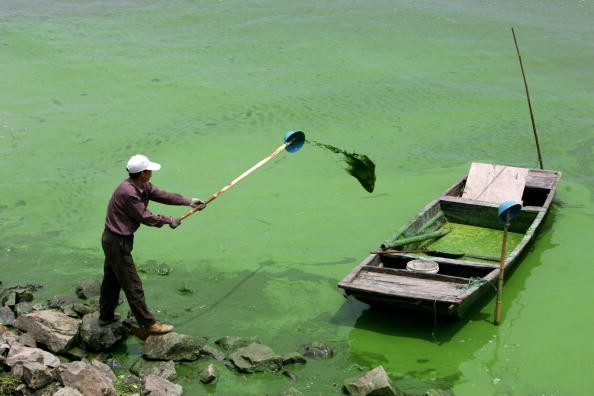Alberta Releases Advisory Against Blue-green Algae Bloom
| KJ Belonio | | Jun 27, 2015 11:06 PM EDT |
(Photo : Getty Images/China Photos) This summer, blue-green algae or cyanobacteria blooms are once again invading Alberta lakes. And since they’re known to cause some harmful effects, the authorities are warning the public to stay out of the water where the algae are visible.
Blue-green algae blooms have been recently detected in areas of Twin Valley Reservoir in Vulcan County in Southeastern Calgary. Since these toxic blooms are starting to show up in Alberta lakes, Alberta Health Services (AHS) has issued an advisory for residents living near the area to take necessary precautions.
Like Us on Facebook
This summer, blue-green algae or cyanobacteria blooms are once again invading Alberta lakes. And since they're known to cause some harmful effects, the authorities are warning the public to stay out of the water where the algae are visible. According to Global News, AHS also warned the residents and any visitors of the lake to consider limiting their consumption of fish and fish trimmings from the lake since fish may store toxins in their liver. In addition, the agency cautioned the residents not to feed their pets with the fishes or fish trimmings from the lake.
"Boiling lake water will not remove the toxins produced by blue-green algae (cyanobacteria)," AHS stated in an advisory. "An alternate source of drinking water should also be provided for pets and livestock while this advisory is active."
As per AHS, exposure to water contaminated with blue-green algae can cause skin irritation, rash, sore throat, sore red eyes, swollen lips, fever, nausea and vomiting and/or diarrhea.
Usually, these symptoms appear one to three hours after contact but are gone in one to two days. Vulcan Advocate emphasized the aforementioned symptoms can be more pronounced in children. However, all humans are at risk of these symptoms.
Blue-green algae (cyanobacteria), which appear like scum, grass clippings, fuzz or globs on the surface of water, is naturally occurring and often smell musty or grassy. Their colors may also vary from blue-green, greenish-brown, brown or pinkish red. However, weather and wind conditions can cause algae blooms to move from one location in the lake to another.
In other news, researchers at the University of Alberta, who monitor 50 lakes and other recreational areas, now have the technology that quickly identifies the species of blue-green algae found in water samples and provides automated cell counts, CBC News reported.
"Those are what are used then to determine whether or not the World Health Organization guideline of 100,000 cells per [million] has been exceeded," biologist Rolf Vinebrooke said. "And if that's the case, then that site can then be designated for the posting of a health advisory."
Tagsblue-green algae, Cyanobacteria, Alberta, Science, Advisory
©2015 Chinatopix All rights reserved. Do not reproduce without permission
EDITOR'S PICKS
-

Did the Trump administration just announce plans for a trade war with ‘hostile’ China and Russia?
-

US Senate passes Taiwan travel bill slammed by China
-

As Yan Sihong’s family grieves, here are other Chinese students who went missing abroad. Some have never been found
-

Beijing blasts Western critics who ‘smear China’ with the term sharp power
-

China Envoy Seeks to Defuse Tensions With U.S. as a Trade War Brews
-

Singapore's Deputy PM Provides Bitcoin Vote of Confidence Amid China's Blanket Bans
-

China warns investors over risks in overseas virtual currency trading
-

Chinese government most trustworthy: survey
-

Kashima Antlers On Course For Back-To-Back Titles
MOST POPULAR
LATEST NEWS
Zhou Yongkang: China's Former Security Chief Sentenced to Life in Prison

China's former Chief of the Ministry of Public Security, Zhou Yongkang, has been given a life sentence after he was found guilty of abusing his office, bribery and deliberately ... Full Article
TRENDING STORY

China Pork Prices Expected to Stabilize As The Supplies Recover

Elephone P9000 Smartphone is now on Sale on Amazon India

There's a Big Chance Cliffhangers Won't Still Be Resolved When Grey's Anatomy Season 13 Returns

Supreme Court Ruled on Samsung vs Apple Dispute for Patent Infringement

Microsoft Surface Pro 5 Rumors and Release Date: What is the Latest?










